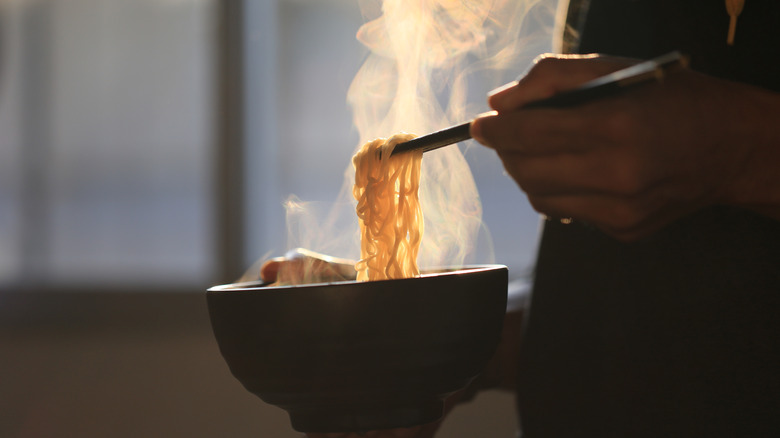How Are Instant Ramen Noodles Dried?
Cooking a package of instant ramen is easy and simple, thanks in large part to the dried pasta that reconstitute into long, soft, flavorful noodles in only minutes after being cooked in boiling water. Without these instant dried noodles, we wouldn't be able to enjoy a quick bowl of ramen.
Ramen was first created by Chinese immigrants living in Japan and working in the country's soba shops, where they combined hearty wheat pasta popular in their homeland with savory Japanese broth. Durable noodles are an important component of ramen because they do not get soggy from absorbing too much broth, per Japanese Cooking 101. Ramen noodles come in a variety of shapes and textures — thin or thick, curly or straight — but this simple yet delicious meal became part of American culture only in the 1970s, a few decades after the Japanese first tasted it, per Myojo.
Traditionally, dried noodles start with fresh, uncooked swirls, according to Serious Eats. This is because the easiest dried noodles to return to a pleasing soft texture are thin and straight. However, a different preservation technique is utilized for the block of pasta wrapped up with a seasoning packet for cheap instant ramen.
Deep-frying dehydrates the noodles
To create crispy swirls for instant ramen, par-cooked bricks of noodles are deep-fried; they dehydrate when deep-fried, Serious Eats notes. This method of creating noodles that could be reconstituted quickly in boiling water was created by Momofuku Ando in 1958. These dried, deep-fried spirals of goodness are most commonly found in the cheap packets of ramen that have become popular around the world; however, buy a more expensive package, and it's more likely that the noodles, once cooked, will have a texture more similar to traditional ramen, according to Serious Eats. That's because higher-end brands air-dry their par-cooked noodles.
Traditionally, wheat flour and vegetable oils are used to make dry ramen noodles, per Healthline, and the delicious swirls have proven to be versatile and suitable for far more than soup. Recipes available from Taste of Home range from Turkey Ramen Noodle Salad (with a topping of crunchy ramen spirals and almonds) to Stir-Fried Scallops and Asparagus on a bed of cooked ramen noodles. Whether you decide to use instant ramen noodles the traditional way in soup or as a topping to give a little crunch to chicken salad, enjoy these specially-made, tasty swirls.

